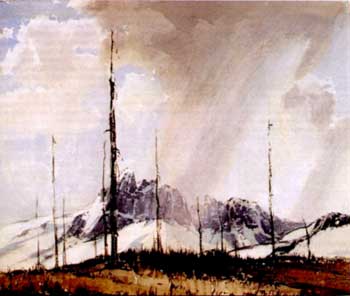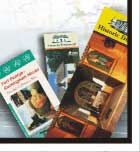|
Page 1 |
2
100 years after his birth, a retrospective of his work recognizes A. C. Leighton's contributions to Art in Alberta.
by Bob Blakey

A.C. Leighton; Cathedral Mountain, 1950, 31.2 x 36.7 cm, watercolour on
paper.
If you walk along a certain narrow trail through a stretch of trees south of Calgary you'll come across a curious bulge on the ground that doesn't fit the flat, wooded terrain.
This arbitrarily chosen spot grew slowly over the years into a weed covered, circular mound. It materialized when Barbara Leighton, wife of the celebrated Alberta landscape artist A.C. Leighton, regularly hauled her husband's discarded drawings and paintings down the trail, tossed them onto an ever-expanding pile, and added another layer of dirt. She did so because he told her to.
Untold hundreds of Leighton's artistic renderings rest in peace under the soil, in what condition we can only imagine. And if their number and nature forever remain secret, it will be just one more enigmatic side to a painter who revealed only what he felt like revealing and nothing more.
Even the English-born artist's birth date causes confusion. Some reference material declares it to be 1901, but the Leighton Foundation has his original birth certificate. Alfred Crocker Leighton came into the world on Dec. 8 , 1900, which is why the non-profit group is organizing a retrospective exhibition this fall to coincide with the centenary of the artist's birth.
"The scale of the country was tremendous," Leighton once said when reflecting on his first contemplation of the limitless panorama.
Best known for his paintings of the Rockies, Leighton was one of many artists who, between the World Wars, hiked into the mountains and attempted to convey their immense grandeur on canvas or paper. Thomas Fripp, for example, took an ethereal, mist approach while the spiritually oriented Lawren Harris leaned more toward the dramatic abstract, rendering each mountain in bold strokes as a kind of rock cathedral thrust heavenward. Such painters as J.E.H. MacDonald, Peter Whyte and Catherine Robb Whyte, Arthur Lismer, Carl Rungius, Walter J. Phillips, and many others brought their own distinctive attitudes to the Rockies.
Leighton came to Alberta as an English landscape watercolourist-refined, well-trained, technically masterful. What he saw in the Rockies overwhelmed him. It also changed him. He in turn would make his mark on Alberta's evolving culture-largely because, unlike other accomplished painters who passed through, he settled in the Calgary area. The mountains weren't just some majestic vista on a grand tour, captured in brush strokes before the artist moved on to the next geographical study. They became Leighton's backyard.
"The scale of the country was tremendous," Leighton once said when reflecting on his first contemplation of the limitless panorama. "I soon found that a 14 x 10 inch [surface] was too small even to rough in [the] composition, and something larger was necessary to portray the magnitude, the imposing force and dignity of those mountains." It must have been a sharp contrast compared with the manageable scale of the southern English countryside where he was born.
Catalogue biographies have described Leighton as the son of a relatively prosperous property owner from Hastings, although the birth certificate lists his father, Charles's, occupation as tailor. Whatever, the case, Alfred grew up in Hastings and, as a teenager in 1918, fibbed about his age to join the Royal Flying Corps. His biplane struck a power line during a training exercise and crashed, causing injuries that would trouble him for life.
The next few years remain something of a puzzle, but it is known that he became an associate of the Royal Academy at age 17, worked as a toy designer, and might have taught art. Canadian Pacific Railway executives in Britain hired Leighton in 1924 to paint watercolour scenes for promotional CPR posters, handing him a railway pass so he could visit the chosen locations in person. Unfortunately, his CPR paintings were destroyed when London was bombed during the Second World War.
In 1929 Leighton founded the Alberta Society of Artists, and in 1933 he established what was to become the visual arts program of the Banff School of Fine Arts. In 1931, he married a former student, Barbara Harvey, taking her on a backpacking-and-painting trip into the mountains for their honeymoon. Happily, Barbara Leighton, who called her husband "Ace," was enthusiastic about such artistic forays and he soon dropped his packhorse excursions with the Trail Riders of the Canadian Rockies in favour of simpler overnight hikes with his wife.

A.C. Leighton; courtesy the Leighton Foundation
He certainly stood out in western Canada as an artist, says Harry Savage, well-known painter and retired University of Alberta art professor, now living in B,C. "In terms of accomplishments, there weren't an awful lot of people doing watercolour at that time in Canada," Savage explains. "He brought us that English tradition and English mannerism. [There were] lots of amateurs, but if you wanted to see a good watercolour, you went to a book or a good reproduction, and there you had Leighton and Maxwell Bates. They and Phillips were the strongest."
|





